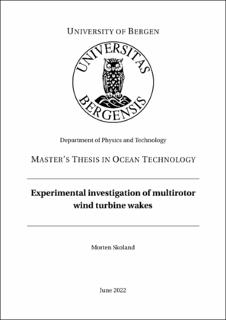Experimental investigation of multirotor wind turbine wakes
Master thesis
Permanent lenke
https://hdl.handle.net/11250/3001124Utgivelsesdato
2022-06-01Metadata
Vis full innførselSamlinger
- Master theses [170]
Sammendrag
With the increasing need for more renewable energy, offshore wind energy has been identified as a critical contributor to help with this increasing demand. However, conventional single rotor wind turbines face challenges in tackling the increased power generation required by each unit, with high costs for installation and maintenance of floating offshore installations. As a result, multirotor wind turbine concepts have emerged as a promising alternative to single rotor wind turbines. This thesis investigates the wake development for several different multirotor setups to contribute to the understanding and viability of multirotors. The effect of inter-rotor spacing, the number of rotors, yawing, additional support structure, and different inflow conditions on the wake development is explored. The wake developments are investigated utilizing porous discs in a towing tank. The wake velocity components have been measured with an Acoustic Doppler Velocimeter. It was found that a multirotor wake has lower initial velocity deficits in the near wake and a lower turbulence level than a single rotor. Further downstream, however, the wake of multirotors recovers slower than the single rotor, which has lower velocity deficits in the far wake. An increase in the disc spacing in the multirotor system is found to decrease the initial velocity deficit and turbulence produced in the wake. However, compared to the setup's increased total diameter, a larger disc spacing showed a faster wake recovery in the far wake. Furthermore, it was found that an increase in the number of discs results in a lower velocity deficit and turbulence level in the near wake. However, it led to a higher velocity deficit in the far wake. These measurements showed the wake-generated turbulence's importance on the downstream wake recovery. Exposing a multirotor setup to turbulent inflow, different yaw configurations, and an additional support structure showed no disadvantages regarding the wake development for the multirotor. In conclusion, the wake of multirotors is shown to be strongly dependent on a number of design parameters. The study highlighted the complex interplay of flow entrainment and turbulence production at different locations in the wake and its effects on wake recovery in different downstream regions of the wake. Previous work on power production shows positive signs for different aspects of multirotor setups. Further work should therefore optimize multirotor system designs for the wake development and power production together and in a wind farm context.
